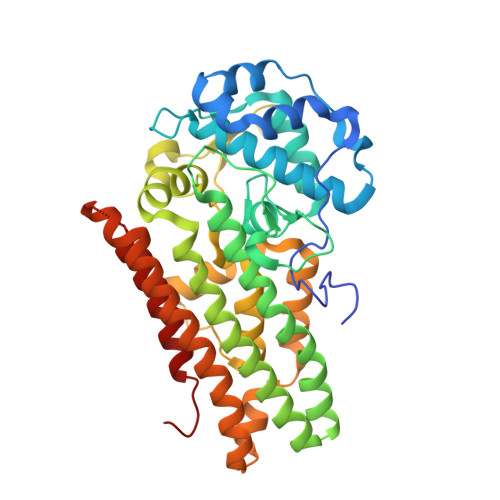Important Hydrogen Bond Networks in Indoleamine 2,3-Dioxygenase 1 (IDO1) Inhibitor Design Revealed by Crystal Structures of Imidazoleisoindole Derivatives with IDO1
Peng, Y.H., Ueng, S.H., Tseng, C.T., Hung, M.S., Song, J.S., Wu, J.S., Liao, F.Y., Fan, Y.S., Wu, M.H., Hsiao, W.C., Hsueh, C.C., Lin, S.Y., Cheng, C.Y., Tu, C.H., Lee, L.C., Cheng, M.F., Shia, K.S., Shih, C., Wu, S.Y.(2016) J Med Chem 59: 282-293
- PubMed: 26642377
- DOI: https://doi.org/10.1021/acs.jmedchem.5b01390
- Primary Citation of Related Structures:
5EK2, 5EK3, 5EK4, 5ETW - PubMed Abstract:
Indoleamine 2,3-dioxygenase 1 (IDO1), promoting immune escape of tumors, is a therapeutic target for the cancer immunotherapy. A number of IDO1 inhibitors have been identified, but only limited structural biology studies of IDO1 inhibitors are available to provide insights on the binding mechanism of IDO1. In this study, we present the structure of IDO1 in complex with 24, a NLG919 analogue with potent activity. The complex structure revealed the imidazole nitrogen atom of 24 to coordinate with the heme iron, and the imidazoleisoindole core situated in pocket A with the 1-cyclohexylethanol moiety extended to pocket B to interact with the surrounding residues. Most interestingly, 24 formed an extensive hydrogen bond network with IDO1, which is a distinct feature of IDO1/24 complex structure and is not observed in the other IDO1 complex structures. Further structure-activity relationship, UV spectra, and structural biology studies of several analogues of 24 demonstrated that extensive hydrophobic interactions and the unique hydrogen bonding network contribute to the great potency of imidazoleisoindole derivatives. These results are expected to facilitate the structure-based drug design of new IDO inhibitors.
Organizational Affiliation:
Institute of Biotechnology and Pharmaceutical Research, National Health Research Institutes, 35, Keyan Road, Zhunan, Miaoli County 35053, Taiwan, ROC.
















